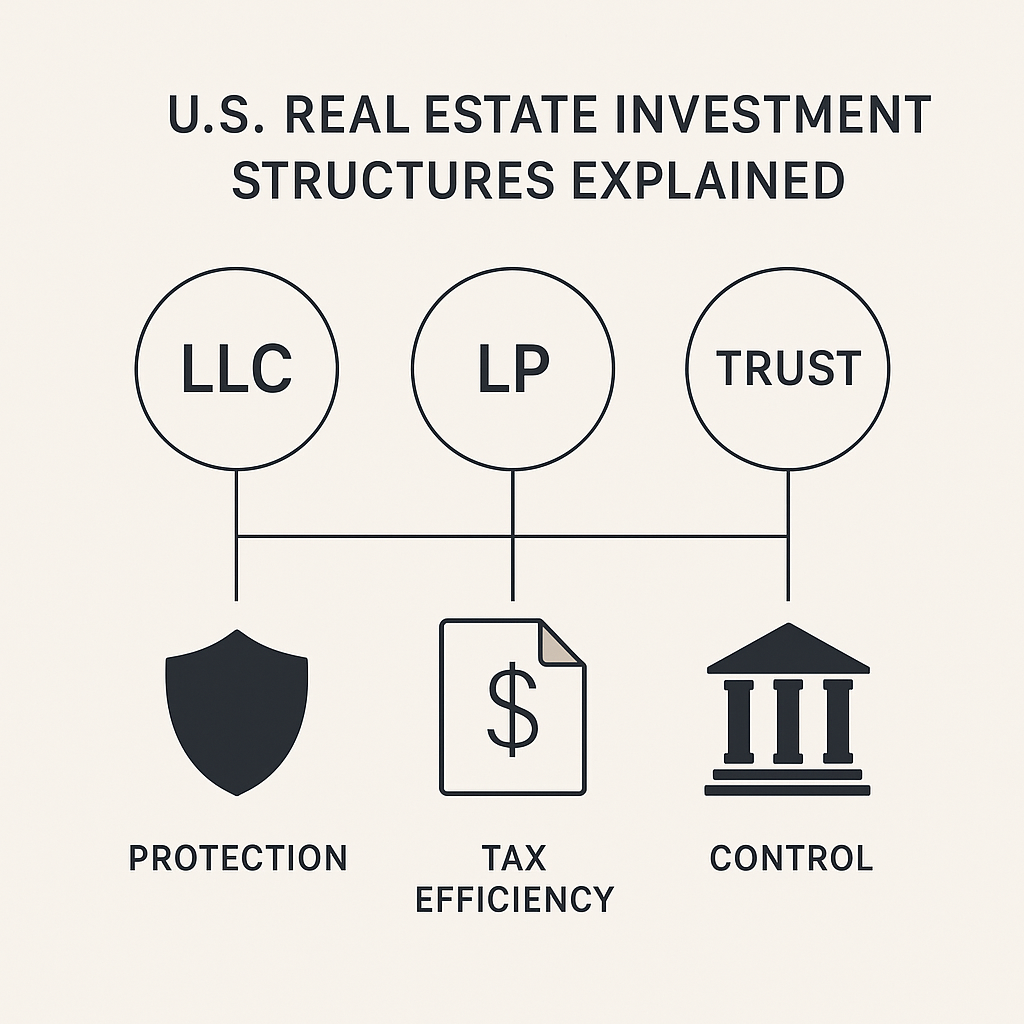Introduction: Why Structure Matters More Than Location
Many investors focus on “where” to buy property in the U.S. but neglect “how” to own it. Your choice of investment structure can be as critical as market timing or property selection. It shapes your tax liabilities, your exposure to risk, and even how easily you can pass wealth to future generations.
At Infinity⁹, we believe there are no bad markets, just bad strategies—and the wrong structure is one of the most expensive mistakes an investor can make.
1. The LLC (Limited Liability Company)
What It Is
A Limited Liability Company is a flexible business entity that separates personal assets from investment liabilities. It’s one of the most common vehicles for real estate ownership in the U.S.
Key Advantages
- Liability Protection: Shields personal assets from lawsuits or debts linked to the property.
- Pass-Through Taxation: Profits and losses are reported on the owner’s personal tax return, avoiding double taxation.
- Operational Flexibility: Fewer formalities than corporations; adaptable for single or multiple members.
Strategic Uses
LLCs are ideal for single-property investments, joint ventures between partners, or as holding entities in a larger portfolio. For international investors, an LLC can provide privacy and efficient ownership without a complex corporate structure.
Potential Drawbacks
Some states have high annual LLC fees, and foreign members may face U.S. tax withholding. Not all lenders are equally comfortable with LLC-owned properties, especially for residential financing.
2. The LP (Limited Partnership)
What It Is
An LP has at least one general partner (GP) managing operations and one or more limited partners (LPs) who provide capital but have no management role.
Key Advantages
- Clear Role Separation: GPs manage; LPs invest.
- Pass-Through Tax Benefits: Like an LLC, LP income passes directly to partners.
- Institutional Familiarity: Common in large-scale real estate syndications.
Strategic Uses
LPs are well-suited for investors who want exposure to a project without day-to-day involvement. They are frequently used in institutional-quality real estate deals, where Infinity⁹ might serve as the GP and investors participate as LPs.
Potential Drawbacks
GPs carry unlimited liability, so the GP role must be carefully structured—often through an LLC to shield personal risk. LPs have limited say in operations, which may not suit hands-on investors.
3. The Trust
What It Is
A trust is a fiduciary arrangement where a trustee holds property for the benefit of beneficiaries. Trusts can be revocable or irrevocable and are often used for estate planning.
Key Advantages
- Estate Planning Efficiency: Bypasses probate and can provide significant privacy.
- Asset Protection: Certain types shield assets from creditors.
- Continuity: Ensures a smooth transfer of ownership upon the investor’s death.
Strategic Uses
Trusts are particularly valuable for investors focused on generational wealth transfer. For non-U.S. investors, a trust can help manage U.S. estate tax exposure while keeping ownership structures discreet.
Potential Drawbacks
Setting up and maintaining a trust can be complex and costly. Tax treatment varies, and poor structuring can trigger unintended liabilities.
Infinity⁹’s Perspective: The Building Capital Framework
Choosing between an LLC, LP, or trust is less about the “best” structure and more about alignment with your investment horizon, tax residency, and operational role. Infinity⁹ applies a Building Capital Framework that prioritizes:
- Protecting capital against unnecessary legal and tax exposure.
- Maximizing after-tax returns across jurisdictions.
- Ensuring structures can scale as your portfolio grows.
For example, we often blend structures—an LLC acting as the GP of an LP, with ownership interests held in a trust—to capture multiple layers of protection and efficiency.
Final Thoughts
Your money doesn’t need a visa, but it does need the right passport in the form of a properly chosen legal structure. Investors who approach structure as a strategic asset—not an afterthought—position themselves for resilience, tax efficiency, and long-term capital growth.







